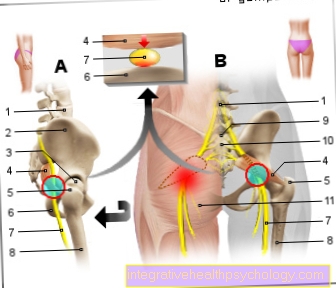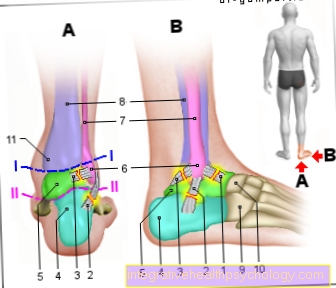Retinitis pigmentosa
introduction
Retinitis pigmentosa is an umbrella term for a group of diseases of the eye, which in their course lead to the destruction of the retina (retina). The retina is, so to speak, the visual layer of our eye, the destruction of which leads to vision loss or blindness. The term "retinitis" is rather misleading because it is not an inflammation of the retina. The term "retinopathia" would be correct, but it has not caught on in everyday medical practice.
The word "pigmentosa" refers to the pigment deposits on the retina that are typical of this disease and that appear as tiny dots in the ophthalmological examination.
In Germany around 30,000 to 40,000 suffer from one of the various forms of retinitis pigmentosa. Since retinitis pigmentosa is currently not curable, it is one of the most common causes of blindness, usually in middle adulthood.

Function of the retina
To understand retinitis pigmentosa, it helps to understand the basic structure and function of the eye.
The human retina represents the light-sensitive layer of the eye. With the help of the rods and cones (light receptors) from which it is made up, the incoming light stimuli can be coded into electrical signals and then passed on to the brain via other nerve tracts, which the incoming information is then processed into the actual image.
However, the light receptors are not identical everywhere in the eye. The rods, which are more in the periphery, i.e. further out in the field of vision, are important for seeing at night and at dusk, so they can perfectly resolve light-dark contrasts, but are not as sharp as the cones.
The cones, on the other hand, which are mainly located in the center of the retina, are fully used during the day. With the cones we perceive the colors that surround us and can see things clearly in the middle of the field of vision.
If you take the field of view of both eyes together, you get an angle of around 180 °. Due to the anatomical and functional structure of our eyes, we are able to perceive our surroundings in a “panoramic setting”. However, we can only see them clearly in the focus of our field of vision, the area in which the incoming image from the left and the right overlap. Here we can also see small details sharply, whereas further outside (i.e. further peripherally) we use the areas more for unconscious orientation.
If our eyes are fully functional, it is not a problem for us to look at a specific, more distant object such as a street sign and the surrounding area, e.g. to perceive an approaching car at the same time.
What types of retinitis pigmentosa are there?
As already mentioned at the beginning, retinitis pigmentosa is basically a collective term for a large number of diseases in which similar processes take place. The classification is sometimes different in different works of the specialist literature, but in principle one can distinguish between three groups of retinitis pigmentosa:
- Primary retinitis pigmentosa
- Associated retinitis pigmentosa
- Pseudo-retinitis pigmentosa.
In addition to these three basic forms, there are other forms of retinitis pigmentosa that cannot be clearly assigned to one of these groups. This also includes the extremely rare treatable forms of retinitis pigmentosa: the atrophia gyrata, the Bassen-Kornzwei syndrome (also known as Abetalipoproteinemia called) and the Refsum syndrome. The focus here is on good cooperation with a metabolism and nutrition specialist in order to be able to get the disease under control.
Primary retinitis pigmentosa
The symptoms and processes in the eye that have been dealt with so far in the text are Primary retinitis pigmentosa, at the 90% of those affected Suffer. The exact genetic causes on which this disease is based have not yet been adequately researched. Until now it could only be determined that different Changes in the genetic makeup and various protein defects are present with those affected. So it happens that the course of the disease can be quite different individually, just that Terminal stage with the complete loss of photoreceptors the retina, is identical in all.
Associated retinitis pigmentosa
Kick the Retinitis pigmentosa not alone, but the patients still suffer other symptomsthat have nothing to do with the eye, it is one Associated retinitis pigmentosa, usually as a partial symptom of a syndrome.
Frequently occurring comorbidities can be: Hearing problems, Muscle weakness to Muscle paralysis, Gait disorders, Stunted growth, Problems with strongly flaky and photosensitive skin, one mental disability, congenital cystic kidneys and or Heart malformations and Cardiac arrhythmias.
The two most common syndromes are the so-called Usher Syndrome as well as that Bardet-Biedl syndrome.
Pseudo-retinitis pigmentosa
From one Pseudo-retinitis pigmentosa or Phenocopy on the other hand, one speaks when the patient does the described typical symptoms have primary retinitis pigmentosa, however no hereditary components can be seen, but rather the destruction of the retinal cells from other diseases was caused.
This can e.g. the case with Autoimmune diseases, Inflammation or Poisoning (through poisons or through drugs or other substances).
Recognizing retinitis pigmentosa
What are the symptoms of retinitis pigmentosa?
The characteristic symptoms that occur include:
- the narrowing and loss of the visual field
- night blindness or impaired vision even at light twilight
- Photosensitivity
- disturbed color perception and
- a noticeably longer period of time until the eyes have adapted to different lighting conditions and different contrasts
The severity and severity as well as the order in which the symptoms appear can be different for everyone.
In retinitis pigmentosa, the visual field gradually shrinks due to the loss of the visual cells. Typically, it narrows more and more from the edge areas until only a small remnant of photoreceptor cells is retained in the very center. This is usually referred to as “tunnel vision” or “tube field of view”. The name alone also illustrates quite well for the person not affected how one can imagine this form of restricted vision.
The visual acuity, on the other hand, can still be reasonably well preserved, so that there are those affected who need aids such as a blind staff to cope with everyday life, but are still able to read a newspaper or a book.
Unfortunately, this combination often leads to the assumption in healthy people that the person suffering from retinitis pigmentosa is only simulating his visual impairment.
It is not uncommon for those affected to become aware of the limitations of the visual field only after an incident or even an accident, since the brain is very well able to compensate for failures in the visual field and to compute a good image of the environment despite everything.
In many patients with retinitis pigmentosa, however, the deficits also manifest themselves quite differently, for example as a circular ring around the focal point (a so-called ring scotoma) or as differently distributed black spots.
Rarely, but in principle also possible, is the beginning of the visual field deficits in the center, at the point of the macula (point of sharpest vision in the retina). Those affected then need aids such as magnifying glasses and the like at a very early stage in order to be able to see objects clearly while their orientation in the room is still relatively good.
Read more on the subject below: Macular edema
Since the rods are affected before the cones in retinitis pigmentosa, the symptom of night blindness occurs much earlier than the visual field defects. For the sick person, this means that they are almost blind at night and need help, while with sufficient light they do not notice any major restrictions.
As soon as the cones are also attacked in the further course, the described failures in the field of vision and an increased sensitivity to light occur, the patients are quickly blinded and darker parts of the image are outshone by lighter ones. This is because the perception of contrast in the human eye only comes about through the interaction of neighboring cones. However, if these are damaged, not only is color perception impaired, but also contrast perception.
This symptom is exacerbated by the glaucoma, which often occurs in people with retinitis pigmentosa. The lens becomes cloudy, which then can no longer bundle the incoming light properly, but rather spreads it, which further promotes the dazzle effect.
Treating retinitis pigmentosa
How is retinitis pigmentosa treated?
To date, there is still no way of curing retinitis pigmentosa. Some studies point to a slightly slower course of the disease when taking vitamin A. Others find hyperbaric oxygen therapy helpful.
Gene therapy approaches and stem cell therapies that try to attack the cause of the disease, namely the defective genes, have only been researched and have not yet been tested.
Retinal implants, which are intended to serve as prostheses, are also being discussed.
Prevention of retinitis pigmentosa
What are the causes of retinitis pigmentosa?
In people who suffer from retinitis pigmentosa, many of the functions of the eye or retina already described are no longer possible due to the destruction of rods and cones. The light receptors gradually die off as part of the disease, whereby the rods are usually affected first and then the cones.
Depending on where the decline of the receptors is strongest, different failures of the visual field and different functional failures can occur.
In most cases, retintis pigmentosa is caused by hereditary or spontaneous mutations of certain genes, which lead to degeneration of the retina or the rods and cones.
If the retinitis pigmentosa is not based on a hereditary component, it is also referred to as pseudo retinitis pigmentosa, in which case the photocells are also destroyed. The triggers here are e.g. Identify autoimmune diseases or inflammatory processes.
Further questions about retinitis pigmentosa
Can Retitinits pigmentosa be inherited?
Anyone who finds out that they have retinitis pigmentosa will sooner or later probably ask themselves the question of whether this disease is hereditary, or with what certainty the causative genes will also be passed on to the offspring.
The number of genes that can lead to the development of retinitis pigmentosa is not certain. So far, more than 45 genes have been identified in which mutations can be the cause of the disease.
Before one can make any statements about the probability of inheritance, an exact diagnosis must be made, which includes a genetic examination. In general, it can be said that more than 50% of all people with retinitis pigmentosa give birth to children with completely healthy eyes (assuming that only one of the two parents is affected).
The remaining 50% have a 50% chance of having healthy children.
However, 100% certainty for a healthy child cannot be predicted. The disease can be based on different gene mutations as well as on different inheritance processes.
The majority of the genes found so far, however, follow a monogenetic inheritance. This means that the harmful mutation is limited to a single gene and does not affect several. The hereditary factors can be passed on in an autosomal dominant, autosomal recessive or gonosomal manner (usually the X chromosome).





























